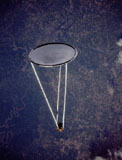


-
In May 1996, NASA tested a new experimental antenna which inflates once in orbit
- The antenna is made of Mylar and supported by three inflatable struts 28 metres long
- The antenna is 15 metres in diameter, about the size of a tennis court
- It looks like a flat parachute, or a round trampoline on an upside down tripod, depending on your point of view
- The experimental antenna inflated from the Spartan satellite automatically when nitrogen gas flowed through it
- At $14 million, inflatable antennas are much cheaper than conventional mechanical ones
- Because they are made out of the material Mylar, they are also much lighter, which makes them easier to launch into space
- They are more reliable and easier to assemble than mechanical antennas because they have fewer moving parts
- Engineers are still researching these antennas
![]()
![]()
